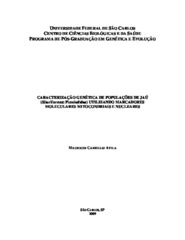Caracterização genética de populações de jaú (Siluriformes: Pimelodidae) utilizando marcadores moleculares mitocondriais e nucleares
Abstract
The genus Zungaro known as jaú, is composed by two species distributed along the rivers of South America: Zungaro jahu is found further south in the basin of the Paraná-Paraguay whereas Zungaro zungaro is found further north in the basin of the rivers Amazon and Orinoco. However, in the literature the classification and distribution of each of those species is still unclear and the basic information on the biology and natural history is scarce. In Brazil the jaú is listed as one of endangered species, over-exploited or threatened by overexploitation; however, the regulations fail to protect the jaú because they have mistakenly identified it as Zungaro zungaro. In Colombia, according to the freshwater species Red Book, the Zungaro zungaro has been declared endangered. Considering the limited information on the population genetics of these fish, the purpose of this study was to obtain the genetic characterization of the jaú population through mitochondrial and nuclear molecular markers. This purpose includes the following research questions: 1- Given the uncertainties encountered in the taxonomic genus Zungaro, is this group composed by two species, or are they two different populations? 2- Considering the jaú´s big size and the fact that they migrate long distances, would than mean that there is a population structure? and 3- The jaú´s endangered condition, its habitat´s changes and overfishing, could be responsible for a reduction of the genetic variation of these catfishes? In order to conduct the characterization we used molecular markers such as the mitochondrial cytochrome b gene, the nuclear gene RAG (Recombination Activation Gene) and the nuclear gene coding for ribosomal protein S7. Additionally, a total of eight polymorphic microsatellite loci capable of producing a considerable genetic variation was prospected. The population analysis of the genus Zungaro with mitochondrial and nuclear markers indicated the existence of a population structure among the individuals sampled. This result is due mainly to the differences between the populations of Pantanal - Paraná and the populations of Meta and Amazon; this finding supports the separation of these species. It was also found that these populations share a central haplotype, indicating a genetic cohesion in the genus, where the populations of Meta-Amazon had a greater number of derived haplotypes suggesting a possible population expansion. The occurrence of a unique and central haplotype to the populations of Pantanal- Parana from which the haplotypes of Meta and the Amazon are derived, when the gene RAG was used, would support the idea that these populations would be the center of dispersion and they would retain the ancestral haplotype. Regarding the prospected microsatellite loci, the results indicated they were efficient in the amplification and verification of polymorphism in Zungaro jahu, and were effective in heterologous amplification of other species of the Pimelodidae family. Statistical analyses on the microsatellites loci showed evidence of a single population of the Z jahu specie inhabiting the north and south Pantanal. In contrast, the two Z zungaro populations studied (the Meta River, basin of the Orinoco and the Amazon River) shown to be significantly different, indicating a population structure. In spite of the jaú being an endangered species, the results of the genetic variation showed values comparable to other species of fish. These results open the possibility of developing clear management programs specifically directed to each of these populations, seeking the protection and recovery of individual fish stocks.
